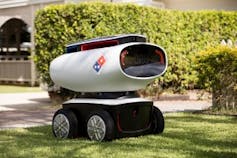Experiments in robotics could help Amazon beat Australia's slow delivery problem
- Written by Kate Letheren, Postdoctoral Research Fellow, Queensland University of Technology
Amazon’s launch in Australia today is likely to put fresh scrutiny on the speed of Australia Post’s own deliveries. To that end, Australia Post is trialling the use of robots to deliver parcels more promptly.
Research finds that consumer trust in a postal brand can influence willingness to purchase from an online retailer who ships with that carrier. Positive perceptions of postal services are not just important to the services themselves, but also to the online retailers who use them.
According to a survey by Choice Australia, this presents a complex problem for Australian delivery services. Australian services face both a large geographic area and a dispersed population. Added to this, globalisation and social media have meant that Australian consumers know that US and European consumers can get their parcels on the same day (albeit at extra cost).
Australia Post is attempting to provide an innovative solution to ensuring efficient deliveries, yet some have criticised the lack of practicality inherent in these robots, which need to be accompanied by a human and can (thus far) only carry one parcel at a time.
Early prototypes of delivery robots
Currently, most delivery robots are used to deliver food.
 Dominos DRU delivery robots RE currently in the trial stage but will be able to deliver piping hot food and ice cold drinks to the customers doorstep.
Dominos
In Australia, Domino’s is trialling “Dru” - a pizza delivery robot. In Silicon Valley too, food delivery robots are being used.
Dominos DRU delivery robots RE currently in the trial stage but will be able to deliver piping hot food and ice cold drinks to the customers doorstep.
Dominos
In Australia, Domino’s is trialling “Dru” - a pizza delivery robot. In Silicon Valley too, food delivery robots are being used.
Delivery robots have raised safety concerns and convenience issues, but overall this is about innovation, and to most effectively use delivery services to add value for the consumer. Imagine a delivery robot that cooks your pizza while driving - ensuring that your pizza is literally hot from the oven when it arrives - Zume pizza is almost there.
Lessons can also be taken from the failings of other autonomous robots - to ensure value, developers must play to the natural strengths of robots rather trying to get robots to emulate human roles.
 This security guard robot met a watery end when it launched itself into a shopping mall fountain.
TWITTER / BILALFAROOQUI
This security guard robot met a watery end when it launched itself into a shopping mall fountain.
TWITTER / BILALFAROOQUI
Robotic security guards can reduce the danger a human security guard is exposed to, and allow for near-constant patrols. However, these robots too have had safety issues with one running into a young boy at a US shopping mall and another reportedly drowning itself in a shopping centre fountain.
Why aren’t these robots everywhere yet?
Australia Post’s robots are still in trial stages and represent the first step towards a day when delivery robots are a standard part of how products are efficiently delivered to customers.
However, there are a range of concerns that need to be addressed before we start seeing delivery robots everywhere. These include:
Inefficiencies: Many delivery robots still need a human minder to ensure everything goes smoothly, help the robot navigate it’s environment, and prevent thefts. Australia needs a more efficient postal network, so inefficiencies like these need to be addressed.
Theft: Of course, there is also the possibility that someone will steal the parcel from the robot before it arrives. This is not the first time that people have raised the idea of stealing from a delivery robot.
This Buzzfeed video shows what happens when you try to steal from a delivery robot.Luckily though, stealing from a robot is about as hard as stealing from a human, with most delivery robots equipped with an array of sensors and cameras that report back to base. These robots also tend to be heavy, making it difficult to pick one up and run with it.
Still in development: Delivery robots are still developing. Additional capabilities are needed to add value for consumers. What if the delivery robot could learn your preferences and share them with other robots involved in deliveries, so you would never have to leave delivery instructions again? Consumers also need the chance to get used to robots, with studies showing that we are more patient with predictable robots, and that we rate robots more favourably when we perceive them to be in our in-group.
The future is robotic
The core service that needs to be offered is safe, reliable, and fast delivery. This needs to happen all over Australia, and if delivery robots can help us reach more people, faster and easier than before, then Australian consumers will welcome the robots.
Any new innovation in delivery services needs to have a relative advantage over previous services. Delivery companies need to consider what would add value for consumers. This value should be something that can be provided better by a delivery robot than by a human.
And of course, delivery robots are fun and novel, but there is a risk of disappointing consumers if robots are not yet ready or don’t perform as well as expected. No doubt Amazon will be working on ways to improve Australian delivery services to meet its expected Australian customer base.
Whether you think they’re ready to deliver your post or not, delivery robots will continue to develop. The prototypes of the first telephone don’t compare to modern equivalents - but without that first step, we wouldn’t be enjoying the benefits of smartphones today. Watch this space.
Authors: Kate Letheren, Postdoctoral Research Fellow, Queensland University of Technology



